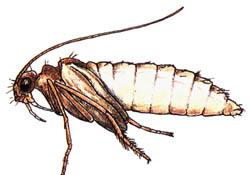Fly Fishing 101, Part 14
Underwater Caddis
Last time we talked about the caddis you can see. Those
that are flying around or floating on the surface of the water.
Trout love them! They may be the most prevelent insect trout
eat. But the ones you see are only a small portion of the ones
trout eat!
How can that be? Remember a while back I said you don't
have to be an expert on insects to catch fish? I didn't lie, but
some basic knowledge will help a lot. Caddis, unlike some of
the insects we will talk about later, are found in primarily two
forms (growth stages) that trout eat. The first, the adult
where they are flying and floating (which we discussed last
week) and the underwater stage where the caddis exists
before becoming an adult.
There are tons of different caddis. So many that several
books have been written on just them — caddis. In the
previous column I recommended one of the latest,
Richards and Braendel's, Caddis Super Hatchesfor detailed
information. Another is Caddisflies by Gary LaFontaine.
Basically, caddis begin as eggs. The tiny larva comes out of
the egg and constructs a case around itself for protection. This
case can be tiny bits of bark, small pebbles, sand or leaf
fragments. As it grows it enlarges the case. In about a year
the larva encases itself in a cocoon of silk and seals itself in.
While in the cocoon the caddis develops legs and wings. When
it is ready to emerge it bites out the end of the cocoon, swims
to the surface, dries it wings and flies away. The caddis mate,
the female lays her eggs and the cycle begins again.
Trout have opportunities to feed on the caddis all through
this cycle. However, studies absolutely prove trout eat 90% of
their diet underwater. By careful observation you can tell if
the trout are feeding beneath the surface.
If trout are not rising — that is taking some insect from the
surface — watch for "bulging." Often trout take the insect just
below the surface, and turn their bodies as they do; resulting
in a "bulge" on the surface. This is often mistaken as a rise by
novice fly fishers.
 Caddis drawing from Presentation by Gary A. Borger
Caddis drawing from Presentation by Gary A. Borger
Drawings by Jason Borger
Published by Tomarrow River Press
Another thing to watch for is a "flash." Watching the water
you may see a flash of the trout's sides. That flash is a sure
indication the trout is feeding subsurface as the caddis swims
towards the surface, or as the insect scurries across the
bottom. These two examples are probably the caddis trout
most often eat.
There are varying opinions on the proper method to fish
nymphs. Technically caddis are not nymphs, but the common
name for underwater insects, and the method of fishing the
imitations has become known as nymphing. One of the most
effective, at least for caddis, is to cast your fly line, using a
rather long "greased" leader. The "greased leader" is simply a
normal leader which has a coating of fly floatant down to
about 4 inches of the fly. The nymph (or weighted nymph)
sinks without the leader being visable.
While current nymphing methods call for casting the line
across the current and letting it travel downstream, this may
not be the most effective method.
Remember the fish are facing into the current — or
upstream. Your chances of hooking a fish directly downstream
are not the best. A better tactic is to cast upstream, again with
the floating line and greased leader. This puts the fly at the
proper eye level for the trout and will help insure hooking the
fish.
It is important to match the size of your fly to the size of
the real insect. Generally commercial nymph patterns are too
large. If you have a choice in nymph patterns, use the smaller
— not the larger.
Look for another tied imitation for caddis just before they
are ready to hatch. These are called emerger patterns. Quite
often emerger patterns are constructed using hackle not
intended to float, also called soft hackle flies. Others have
trailing pieces of mylar or other materials tied at the rear to
represent the shucks.
If your casting is not perfect, or nymphs are not your view
of fly fishing is about, be sure to check out the
Fly of the Week Archives
for other very productive dry fly caddis imitations. Next: Stone flies.
Stop by the Chat Room and meet some fellow
anglers. It is a nice bunch of people - always willing to lend a hand! Or just share your
fishing adventures. Fair skys and tight lines, ~ DB
Have a question? Email me!
Beginners Archives
|